Change in Time Perception Following the Place of Pre-Existence Technique
Abstract
:1. Introduction
Meditation, Time Perception, and Biological Sex
2. Materials and Methods
2.1. Participants and General Procedure
2.2. Place of Pre-Existence Technique (PPEt)
2.3. Measures
2.4. Statistical Analysis
3. Results
3.1. rmANCOVA
3.1.1. Relaxation
3.1.2. Body Awareness
3.1.3. Space Awareness
3.1.4. Time Intensity
3.1.5. Time Speed
3.1.6. MANCOVA
3.2. Prominence of Time: Past, Present, Future
3.2.1. Past
3.2.2. Present
3.2.3. Future
3.3. Correlations between Indexes of Interest between Time Points
4. Discussion
4.1. Collapsing the Phenomenological Features of Experience
4.2. Effects of Sex and Meditation Expertise on Space Awareness and Time Perception
5. Conclusions, Limitations, and Future Studies
Author Contributions
Funding
Institutional Review Board Statement
Informed Consent Statement
Data Availability Statement
Conflicts of Interest
References
- Lutz, A.; Dunne, J.D.; Davidson, R.J. Meditation and the Neuroscience of Consciousness: An Introduction. In The Cambridge Handbook of Consciousness; Zelazo, P.D., Moscovitch, M., Thompson, E., Eds.; Cambridge University Press: Cambridge, UK, 2007; pp. 499–552. [Google Scholar]
- Paoletti, P.; Leshem, R.; Pellegrino, M.; Ben-Soussan, T.D. Tackling the Electro-Topography of the Selves through the Sphere Model of Consciousness. Front. Psychol. 2022, 13, 836290. [Google Scholar] [CrossRef] [PubMed]
- Mason, L.I.; Alexander, C.N.; Travis, F.T.; Marsh, G.; Orme-Johnson, D.W.; Gackenbach, J.; Mason, D.C.; Rainforth, M.; Walton, K.G. Electrophysiological Correlates of Higher States of Consciousness During Sleep in Long-Term. Sleep 1997, 20, 102–110. [Google Scholar] [CrossRef] [PubMed] [Green Version]
- Tart, C.T. Altered States of Consciousness; Doubleday: Garden City, NY, USA, 1972. [Google Scholar]
- Damasio, A. The Feeling of What Happens: Body and Emotion in the Making of Consciousness; Harcourt College Publishers: Fort Worth, TX, USA, 1999; Volume 386, p. xiv. [Google Scholar]
- Paoletti, P.; Ben-Soussan, T.D. Reflections on Inner and Outer Silence and Consciousness without Contents According to the Sphere Model of Consciousness. Front. Psychol. 2020, 11, 1807. [Google Scholar] [CrossRef] [PubMed]
- Panksepp, J. Affective Neuroscience: The Foundations of Human and Animal Emotions; Oxford University Press: New York, NY, USA, 2004. [Google Scholar]
- Wittmann, M. Modulations of the experience of self and time. Conscious. Cogn. 2015, 38, 172–181. [Google Scholar] [CrossRef]
- Jerath, R.; Crawford, M.W.; Barnes, V.A. A unified 3D default space consciousness model combining neurological and physiological processes that underlie conscious experience. Front. Psychol. 2015, 6, 1204. [Google Scholar] [CrossRef]
- Khachouf, O.T.; Poletti, S.; Pagnoni, G. The embodied transcendental: A Kantian perspective on neurophenomenology. Front. Hum. Neurosci. 2013, 7, 611. [Google Scholar] [CrossRef] [Green Version]
- Craig, A.D. Interoception: The sense of the physiological condition of the body. Curr. Opin. Neurobiol. 2003, 13, 500–505. [Google Scholar] [CrossRef]
- Paoletti, P.; Ben Soussan, T.D. The Sphere Model of Consciousness: From Geometrical to Neuro-Psycho-Educational Perspectives. Log. Univers. 2019, 13, 395–415. [Google Scholar] [CrossRef] [Green Version]
- Paoletti, P.; Di Giuseppe, T.; Lillo, C.; Ben-Soussan, T.D.; Bozkurt, A.; Tabibnia, G.; Kelmendi, K.; Warthe, G.W.; Leshem, R.; Bigo, V.; et al. What can we learn from the COVID-19 pandemic? Resilience for the future and neuropsychopedagogical insights. Front. Psychol. 2022, 13, 993991. [Google Scholar] [CrossRef]
- Di Giuseppe, T.; Perasso, G.; Mazzeo, C.; Maculan, A.; Vianello, F.; Paoletti, P. Envisioning the Future: A Neuropsycho-Pedagogical Intervention on Resilience Predictors among Inmates during the Pandemic. Ric. Psicol. 2022. [Google Scholar] [CrossRef]
- Nave, O.; Trautwein, F.-M.; Ataria, Y.; Dor-Ziderman, Y.; Schweitzer, Y.; Fulder, S.; Berkovich-Ohana, A. Self-Boundary Dissolution in Meditation: A Phenomenological Investigation. Brain Sci. 2021, 11, 819. [Google Scholar] [CrossRef] [PubMed]
- Pintimalli, A.; Di Giuseppe, T.; Serantoni, G.; Glicksohn, J.; Ben-Soussan, T.D. Dynamics of the Sphere Model of Consciousness: Silence, Space, and Self. Front. Psychol. 2020, 11, 548813. [Google Scholar] [CrossRef] [PubMed]
- Paoletti, P.; Bombi, A.S. The Empty Space: The Importance of Parental Attention, Neutrality and Observation in the Parent Child Relationship. In Proceedings of the Second International Conference on Mindfulness (ICM-2), Rome, Italy, 11–15 May 2016. [Google Scholar]
- Laukkonen, R.E.; Slagter, H.A. From many to (n)one: Meditation and the plasticity of the predictive mind. Neurosci. Biobehav. Rev. 2021, 128, 199–217. [Google Scholar] [CrossRef] [PubMed]
- Aitken, R.C. Measurement of feelings using visual analogue scales. Proc. R. Soc. Med. 1969, 62, 989–993. [Google Scholar] [PubMed]
- Pfeifer, E.; Sarikaya, A.; Wittmann, M. Changes in States of Consciousness during a Period of Silence after a Session of Depth Relaxation Music Therapy (DRMT). Music Med. 2016, 8, 180–186. [Google Scholar] [CrossRef]
- Jokic, T.; Zakay, D.; Wittmann, M. Individual Differences in Self-Rated Impulsivity Modulate the Estimation of Time in a Real Waiting Situation. Timing Time Percept. 2018, 6, 71–89. [Google Scholar] [CrossRef]
- Luders, E.; Thompson, P.M.; Kurth, F. Larger hippocampal dimensions in meditation practitioners: Differential effects in women and men. Front. Psychol. 2015, 6, 186. [Google Scholar] [CrossRef]
- Upchurch, D.M.; Johnson, P.J. Gender Differences in Prevalence, Patterns, Purposes, and Perceived Benefits of Meditation Practices in the United States. J. Women’s Health 2019, 28, 135–142. [Google Scholar] [CrossRef]
- Unsworth, S.; Palicki, S.-K.; Lustig, J. The Impact of Mindful Meditation in Nature on Self-Nature Interconnectedness. Mindfulness 2016, 7, 1052–1060. [Google Scholar] [CrossRef]
- Ben-Soussan, T.D.; Berkovich-Ohana, A.; Glicksohn, J.; Goldstein, A. A suspended act: Increased reflectivity and gender-dependent electrophysiological change following Quadrato Motor Training. Front. Psychol. 2014, 5, 55. [Google Scholar] [CrossRef] [Green Version]
- Ben-Soussan, T.D.; Glicksohn, J. Gender-Dependent Changes in Time Production Following Quadrato Motor Training in Dyslexic and Normal Readers. Front. Comput. Neurosci. 2018, 12, 71. [Google Scholar] [CrossRef] [Green Version]
- Ben-Soussan, T.D.; Mauro, F.; Lasaponara, S.; Glicksohn, J.; Marson, F.; Berkovich-Ohana, A. Fully immersed: State absorption and electrophysiological effects of the OVO Whole-Body Perceptual Deprivation chamber. Prog. Brain Res. 2019, 244, 165–184. [Google Scholar] [CrossRef]
- Glicksohn, J.; Berkovich-Ohana, A.; Mauro, F.; Ben-Soussan, T.D. Individual EEG alpha profiles are gender-dependent and indicate subjective experiences in Whole-Body Perceptual Deprivation. Neuropsychologia 2019, 125, 81–92. [Google Scholar] [CrossRef]
- Pellegrino, M.; Glicksohn, J.; Marson, F.; Ferraiuolo, F.; Ben-Soussan, T.D. The Cloud of Unknowing: Cognitive Dedifferentiation in Whole-Body Perceptual Deprivation. In Neurophysiology of Silence; Progress in Brain Research; Elsevier: Amsterdam, The Netherlands, 2023; ISBN 9780323995511. [Google Scholar]
- Fabbri, M.; Cellini, N.; Martoni, M.; Tonetti, L.; Natale, V. The Mechanisms of Space-Time Association: Comparing Motor and Perceptual Contributions in Time Reproduction. Cogn. Sci. 2013, 37, 1228–1250. [Google Scholar] [CrossRef]
- Pinder, C.C.; Harlos, K.P. Employee Silence: Quiescence and Acquiescence as Responses to Perceived Injustice. In Research in Personnel and Human Resources Management; Emerald (MCB UP): Bingley, UK, 2001; Volume 20, pp. 331–369. [Google Scholar]
- Paoletti, P.; Selvaggio, A. Mediazione: Quaderni Di Pedagogia per Il Terzo Millennio; Edizioni 3P: Perugia, Italy, 2011. [Google Scholar]
- Bigo, V. On Silence, Creativity and Ethics in Organization Studies. Organ. Stud. 2018, 39, 121–133. [Google Scholar] [CrossRef] [Green Version]
- Satterthwaite, F.E. An Approximate Distribution of Estimates of Variance Components. Biom. Bull. 1946, 2, 110. [Google Scholar] [CrossRef] [Green Version]
- Benjamini, Y.; Hochberg, Y. Controlling the False Discovery Rate: A Practical and Powerful Approach to Multiple Testing. J. R. Stat. Soc. Ser. B Methodol. 1995, 57, 289–300. [Google Scholar] [CrossRef]
- Pek, J.; Wong, O.; Wong, A.C.M. How to Address Non-normality: A Taxonomy of Approaches, Reviewed, and Illustrated. Front. Psychol. 2018, 9, 2104. [Google Scholar] [CrossRef] [Green Version]
- Nevill, A.M.; Lane, A.M. Why self-report “Likert” scale data should not be log-transformed. J. Sports Sci. 2007, 25, 1–2. [Google Scholar] [CrossRef]
- Ataria, Y.; Dor-Ziderman, Y.; Berkovich-Ohana, A. How does it feel to lack a sense of boundaries? A case study of a long-term mindfulness meditator. Conscious. Cogn. 2015, 37, 133–147. [Google Scholar] [CrossRef]
- Agee, J.D.; Danoff-Burg, S.; Grant, C.A. Comparing Brief Stress Management Courses in a Community Sample: Mindfulness Skills and Progressive Muscle Relaxation. Explore 2009, 5, 104–109. [Google Scholar] [CrossRef] [PubMed]
- Fujino, H. Effects of Dohsa-hou relaxation on body awareness and psychological distress1: Body Awareness and Effects of Dohsa-Hou Relaxation. Jpn. Psychol. Res. 2012, 54, 388–399. [Google Scholar] [CrossRef]
- Droit-Volet, S.; Gil, S. The time–emotion paradox. Philos. Trans. R. Soc. B Biol. Sci. 2009, 364, 1943–1953. [Google Scholar] [CrossRef] [PubMed]
- Schirmer, A. How Emotions Change Time. Front. Integr. Neurosci. 2011, 5, 58. [Google Scholar] [CrossRef] [Green Version]
- Simmons, W.K.; Avery, J.A.; Barcalow, J.C.; Bodurka, J.; Drevets, W.C.; Bellgowan, P. Keeping the body in mind: Insula functional organization and functional connectivity integrate interoceptive, exteroceptive, and emotional awareness: Functional Organization. Hum. Brain Mapp. 2013, 34, 2944–2958. [Google Scholar] [CrossRef]
- Wittmann, M. The inner sense of time: How the brain creates a representation of duration. Nat. Rev. Neurosci. 2013, 14, 217–223. [Google Scholar] [CrossRef]
- Meissner, K.; Wittmann, M. Body signals, cardiac awareness, and the perception of time. Biol. Psychol. 2011, 86, 289–297. [Google Scholar] [CrossRef]
- Roche, S.M.; McConkey, K.M. Absorption: Nature, assessment, and correlates. J. Pers. Soc. Psychol. 1990, 59, 91–101. [Google Scholar] [CrossRef]
- Tellegen, A. Practicing the two disciplines for relaxation and enlightenment: Comment on “Role of the feedback signal in electromyograph biofeedback: The relevance of attention” by Qualls and Sheehan. J. Exp. Psychol. Gen. 1981, 110, 217–226. [Google Scholar] [CrossRef]
- Tellegen, A.; Waller, N.G. Exploring Personality through Test Construction: Development of the Multidimensional Personality Questionnaire. In The SAGE Handbook of Personality Theory and Assessment: Volume 2—Personality Measurement and Testing; SAGE Publications Ltd.: London, UK, 2008; pp. 261–292. [Google Scholar]
- Tellegen, A.; Atkinson, G. Openness to absorbing and self-altering experiences (“absorption”), a trait related to hypnotic susceptibility. J. Abnorm. Psychol. 1974, 83, 268–277. [Google Scholar] [CrossRef]
- Glicksohn, J. Temporal Cognition and the Phenomenology of Time: A Multiplicative Function for Apparent Duration. Conscious. Cogn. 2001, 10, 1–25. [Google Scholar] [CrossRef] [Green Version]
- Wahbeh, H.; Sagher, A.; Back, W.; Pundhir, P.; Travis, F. A Systematic Review of Transcendent States Across Meditation and Contemplative Traditions. Explore 2018, 14, 19–35. [Google Scholar] [CrossRef]
- Berkovich-Ohana, A.; Dor-Ziderman, Y.; Glicksohn, J.; Goldstein, A. Alterations in the sense of time, space, and body in the mindfulness-trained brain: A neurophenomenologically-guided MEG study. Front. Psychol. 2013, 4, 912. [Google Scholar] [CrossRef] [Green Version]
- Wittmann, M. Altered States of Consciousness: Experiences Out of Time and Self; MIT Press: Cambridge, MA, USA, 2018. [Google Scholar]
- Linares Gutiérrez, D.; Schmidt, S.; Meissner, K.; Wittmann, M. Changes in Subjective Time and Self during Meditation. Biology 2022, 11, 1116. [Google Scholar] [CrossRef]
- Turner, K. Mindfulness: The Present Moment in Clinical Social Work. Clin. Soc. Work J. 2009, 37, 95–103. [Google Scholar] [CrossRef]
- Tang, Y.-Y.; Hölzel, B.K.; Posner, M.I. The neuroscience of mindfulness meditation. Nat. Rev. Neurosci. 2015, 16, 213–225. [Google Scholar] [CrossRef]
- Jain, S.; Shapiro, S.L.; Swanick, S.; Roesch, S.C.; Mills, P.J.; Bell, I.; Schwartz, G.E.R. A randomized controlled trial of mindfulness meditation versus relaxation training: Effects on distress, positive states of mind, rumination, and distraction. Ann. Behav. Med. 2007, 33, 11–21. [Google Scholar] [CrossRef]
- Ramel1, W.; Goldin, P.R.; Carmona, P.E.; McQuaid, J.R. The Effects of Mindfulness Meditation on Cognitive Processes and Affect in Patients with Past Depression. Cogn. Ther. Res. 2004, 28, 433–455. [Google Scholar] [CrossRef]
- Feruglio, S.; Matiz, A.; Grecucci, A.; Pascut, S.; Fabbro, F.; Crescentini, C. Differential effects of mindfulness meditation conditions on repetitive negative thinking and subjective time perspective: A randomized active-controlled study. Psychol. Health 2021, 36, 1275–1298. [Google Scholar] [CrossRef]
- Halpern, D.F. Sex Differences in Cognitive Abilities; Psychology Press: London, UK, 2000. [Google Scholar]
- Hines, M. Brain Gender; Oxford University Press: Oxford, UK, 2004. [Google Scholar]
- Linn, M.C.; Petersen, A.C. Emergence and Characterization of Sex Differences in Spatial Ability: A Meta-Analysis. Child Dev. 1985, 56, 1479. [Google Scholar] [CrossRef]
- Beaumont, J.G.; Mayes, A.R.; Rugg, M.D. Asymmetry in EEG alpha coherence and power: Effects of task and sex. Electroencephalogr. Clin. Neurophysiol. 1978, 45, 393–401. [Google Scholar] [CrossRef] [PubMed]
- Corsi-Cabrera, M.; Arce, C.; Ramos, J.; Guevara, M.A. Effect of spatial ability and sex inter- and intrahemispheric correlation of EEG activity. Electroencephalogr. Clin. Neurophysiol. 1997, 102, 5–11. [Google Scholar] [CrossRef] [PubMed]
- Volf, N.V.; Razumnikova, O.M. Sex differences in EEG coherence during a verbal memory task in normal adults. Int. J. Psychophysiol. 1999, 34, 113–122. [Google Scholar] [CrossRef] [PubMed]
- Alexander, C.N.; Boyer, R.W.; Alexander, V.K. Higher States of Consciousness in the Vedic Psychology of Maharishi Mahesh Yogi: A Theoretical Introduction and Research Review. Mod. Sci. Vedic Sci. 1987, 1, 89–126. [Google Scholar]
- Aftanas, L.I.; Golocheikine, S.A. Human anterior and frontal midline theta and lower alpha reflect emotionally positive state and internalized attention: High-resolution EEG investigation of meditation. Neurosci. Lett. 2001, 310, 57–60. [Google Scholar] [CrossRef]
- Baijal, S.; Srinivasan, N. Theta activity and meditative states: Spectral changes during concentrative meditation. Cogn. Process. 2010, 11, 31–38. [Google Scholar] [CrossRef]
- Travis, F. Autonomic and EEG patterns distinguish transcending from other experiences during Transcendental Meditation practice. Int. J. Psychophysiol. 2001, 42, 1–9. [Google Scholar] [CrossRef]
- Travis, F.; Haaga, D.A.F.; Hagelin, J.; Tanner, M.; Nidich, S.; Gaylord-King, C.; Grosswald, S.; Rainforth, M.; Schneider, R.H. Effects of Transcendental Meditation practice on brain functioning and stress reactivity in college students. Int. J. Psychophysiol. 2009, 71, 170–176. [Google Scholar] [CrossRef]
- Travis, F.; Tecce, J.; Arenander, A.; Wallace, R.K. Patterns of EEG coherence, power, and contingent negative variation characterize the integration of transcendental and waking states. Biol. Psychol. 2002, 61, 293–319. [Google Scholar] [CrossRef]
- Zimbardo, P.G.; Boyd, J.N. Putting Time in Perspective: A Valid, Reliable Individual-Differences Metric. In Time Perspective Theory; Review, Research and Application; Stolarski, M., Fieulaine, N., van Beek, W., Eds.; Springer International Publishing: Cham, Switzerland, 2015; pp. 17–55. [Google Scholar]
- D’Alessio, M.; Guarino, A.; De Pascalis, V.; Zimbardo, P.G. Testing Zimbardo’s Stanford Time Perspective Inventory (STPI)-Short Form. Time Soc. 2003, 12, 333–347. [Google Scholar] [CrossRef] [Green Version]
- Ely, R.; Mercurio, A. Time perspective and autobiographical memory: Individual and gender differences in experiencing time and remembering the past. Time Soc. 2011, 20, 375–400. [Google Scholar] [CrossRef]
- Fuentes, A.; Oyanadel, C.; Zimbardo, P.; González-Loyola, M.; Olivera-Figueroa, L.A.; Peñate, W. Mindfulness and Balanced Time Perspective: Predictive Model of Psychological Well-Being and Gender Differences in College Students. Eur. J. Investig. Health Psychol. Educ. 2022, 12, 306–318. [Google Scholar] [CrossRef]
- Berry, M.J.; Brivanlou, I.H.; Jordan, T.A.; Meister, M. Anticipation of moving stimuli by the retina. Nature 1999, 398, 334–338. [Google Scholar] [CrossRef]
- Dennett, D.C.; Carfax Publishing. The Origins of selves. Cogito 1989, 3, 163–173. [Google Scholar] [CrossRef] [Green Version]
- Libet, B. Unconscious cerebral initiative and the role of conscious will in voluntary action. Behav. Brain Sci. 1985, 8, 529–539. [Google Scholar] [CrossRef] [Green Version]
- Baars, B.J. Metaphors of consciousness and attention in the brain. Trends Neurosci. 1998, 21, 58–62. [Google Scholar] [CrossRef]
- Gazzaniga, M.S. The Social Brain: Discovering the Networks of the Mind; Basic Books: New York, NY, USA, 1985. [Google Scholar]
- Agerström, J.; Björklund, F. Why People with an Eye toward the Future Are More Moral: The Role of Abstract Thinking. Basic Appl. Soc. Psychol. 2013, 35, 373–381. [Google Scholar] [CrossRef]
- Zimbardo, P.G.; Boyd, J. The Time Paradox: The New Psychology of Time That Will Change Your Life, 1st ed.; Free Press: New York, NY, USA, 2008. [Google Scholar]
- Senyk, O.; Abramov, V.; Bedan, V.; Bunas, A.; Hrechkosii, M.; Lutsenko, O.; Mandzyk, T.; Wittmann, M. Differences in Time Perspectives Measured under the Dramatically Changing Socioeconomic Conditions during the Ukrainian Political Crises in 2014/2015. Int. J. Environ. Res. Public Health 2022, 19, 7465. [Google Scholar] [CrossRef]
- Kosak, F.; Schelhorn, I.; Wittmann, M. The subjective experience of time during the pandemic in Germany: The big slowdown. PLoS ONE 2022, 17, e0267709. [Google Scholar] [CrossRef]
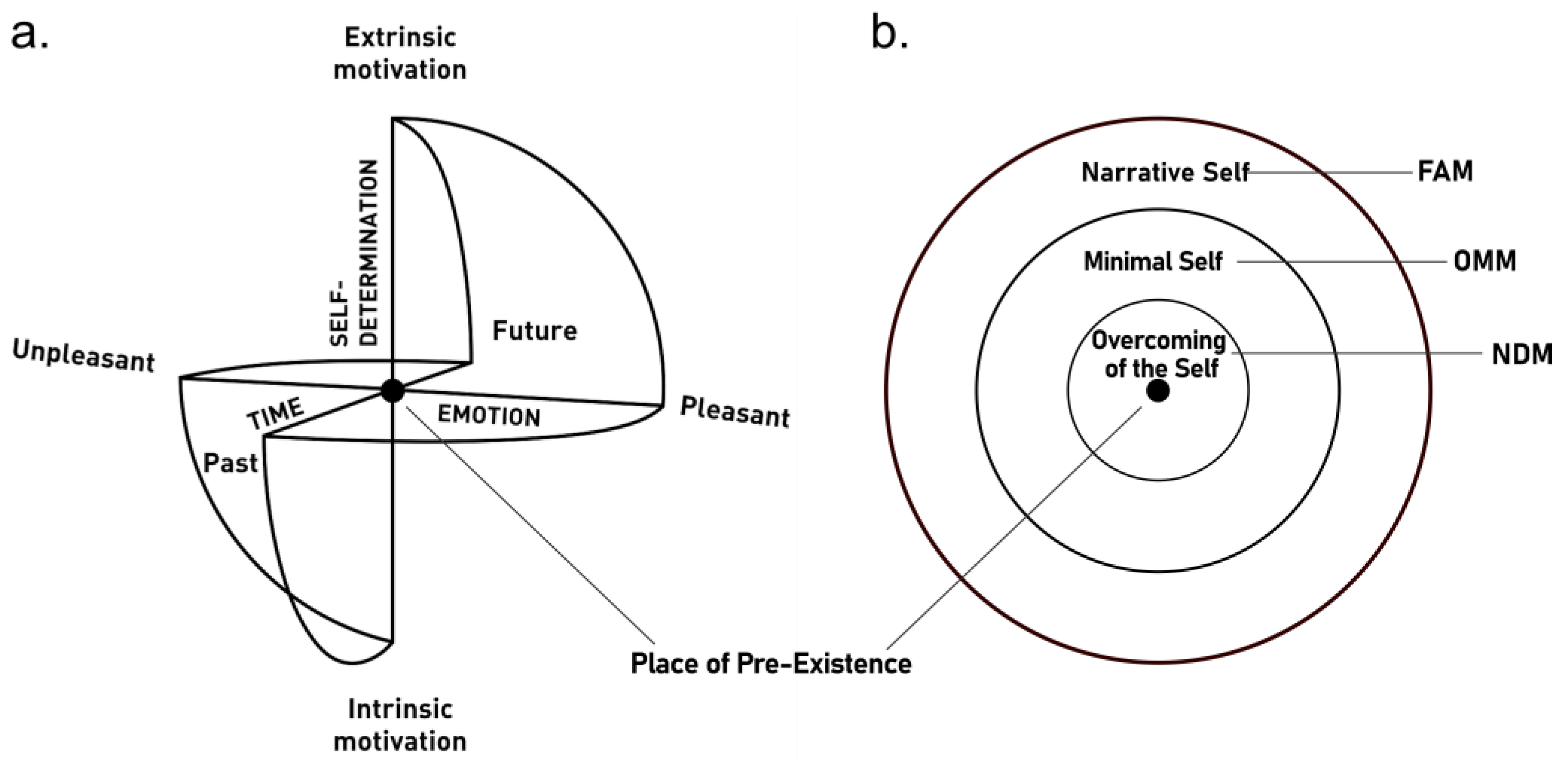
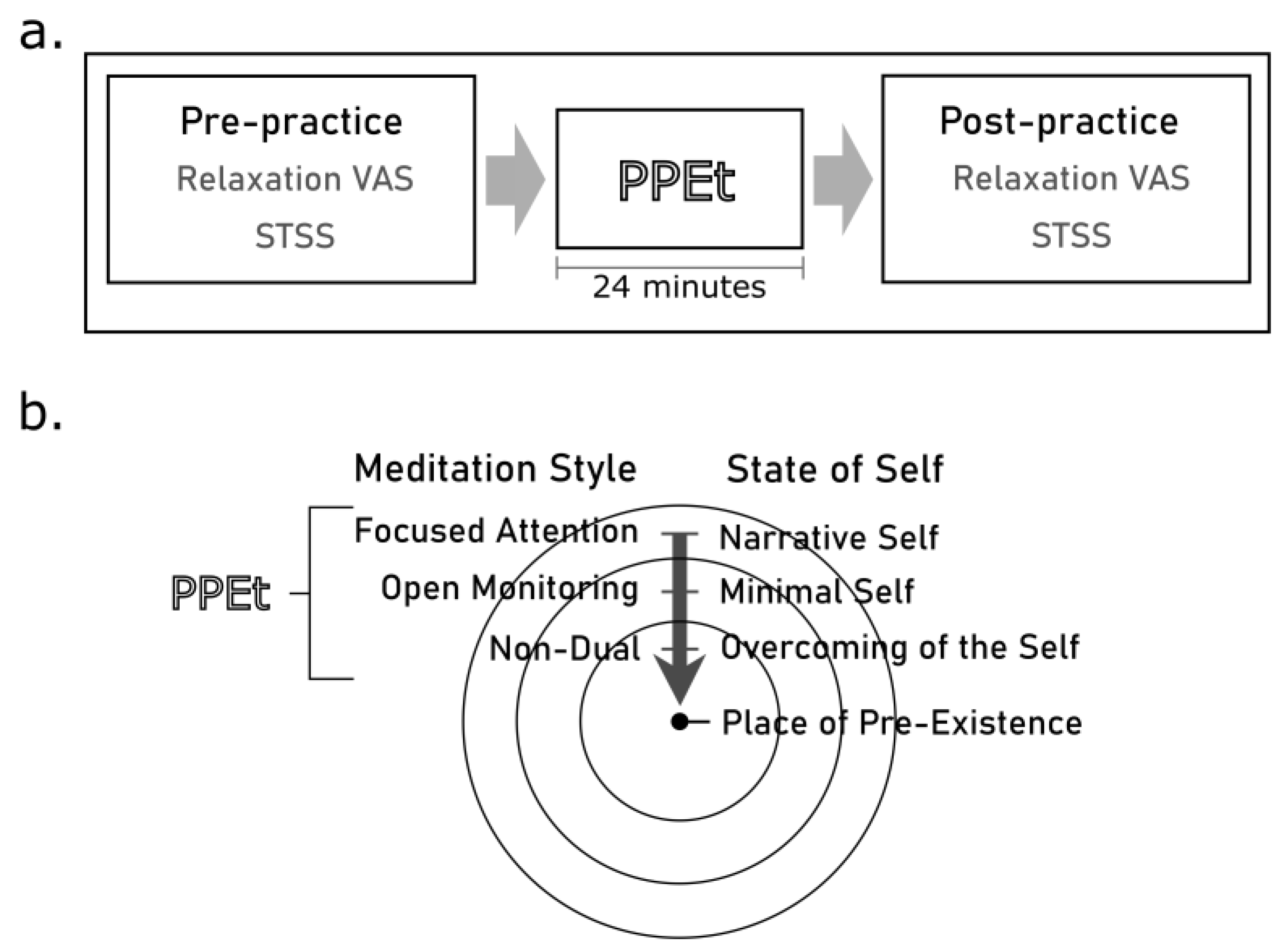
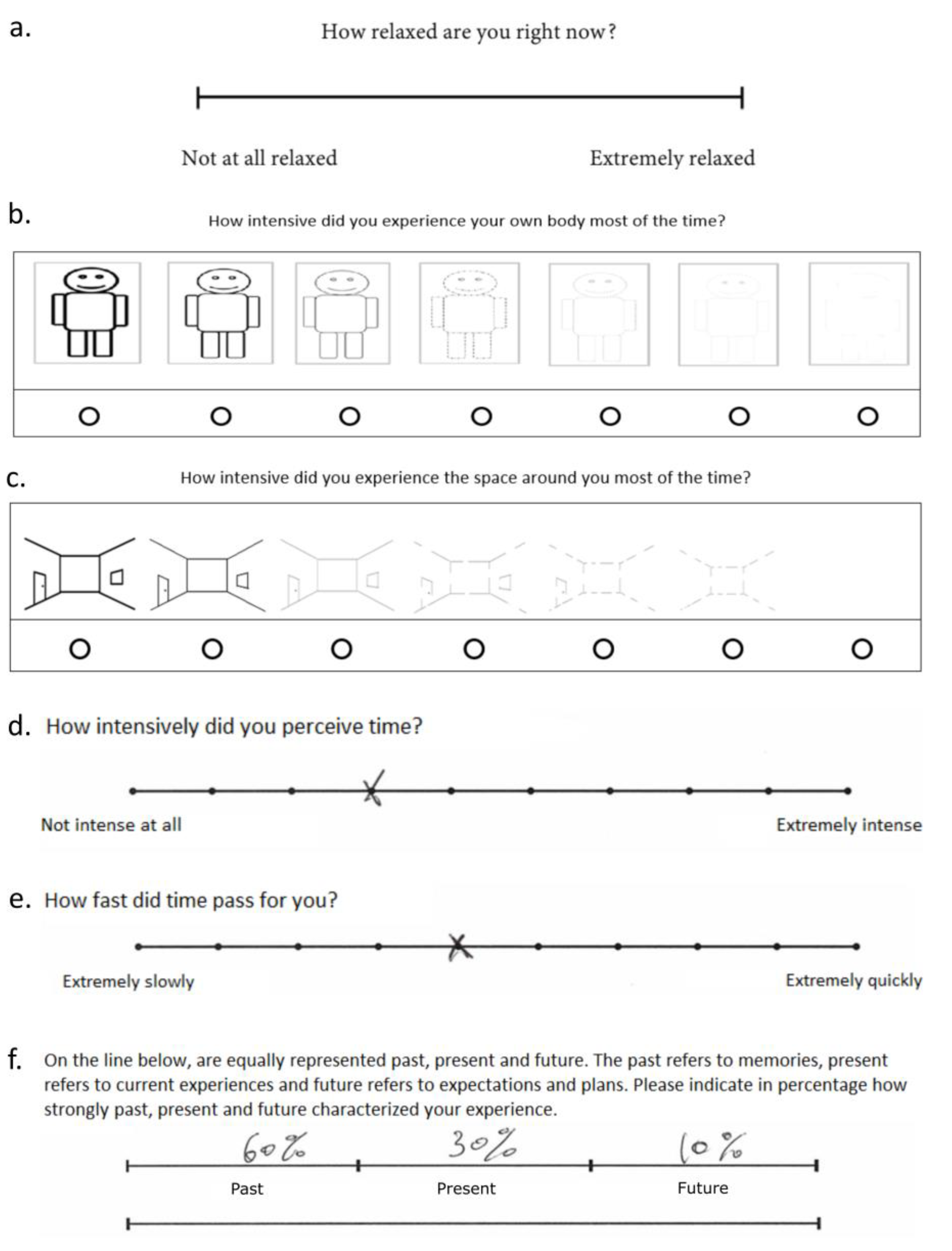

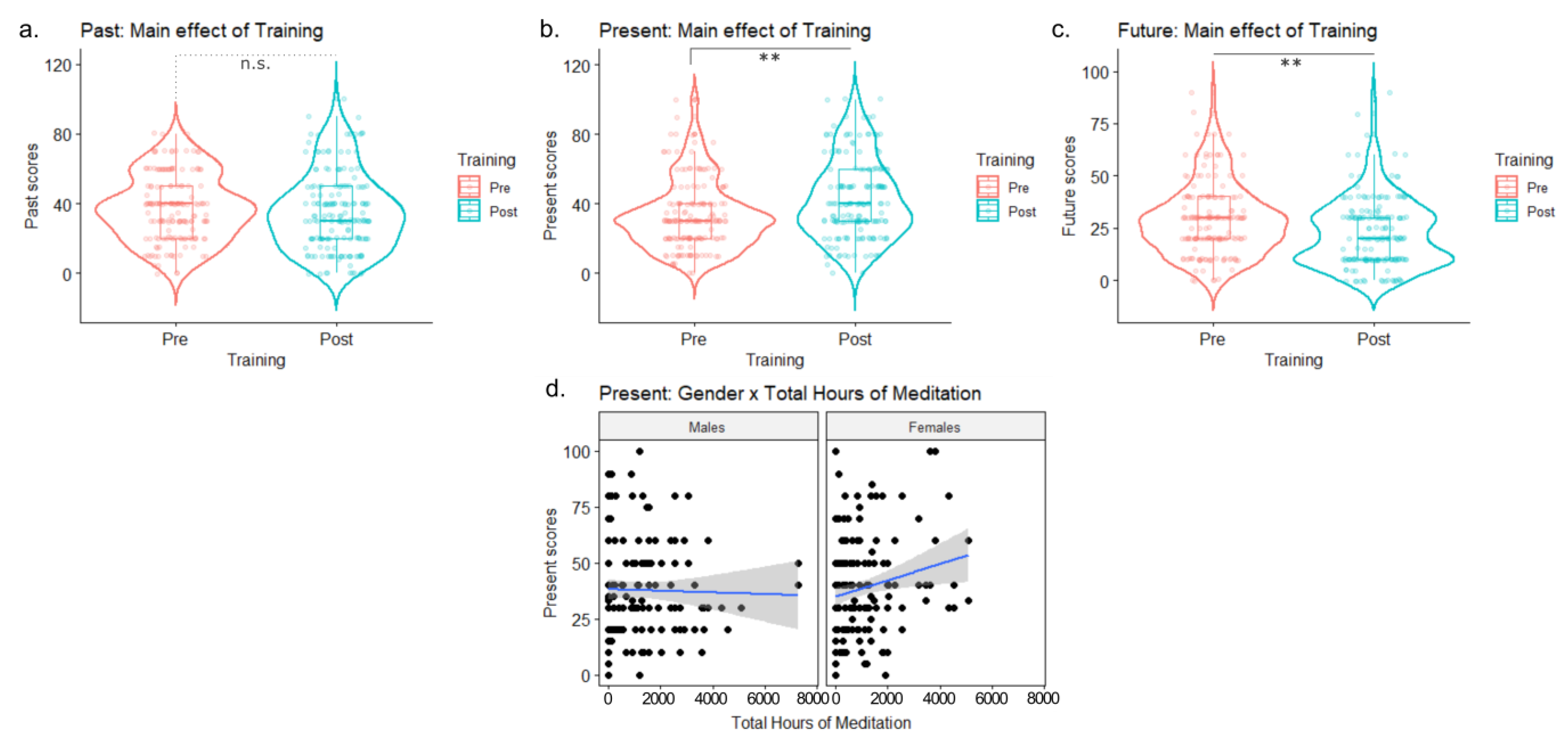
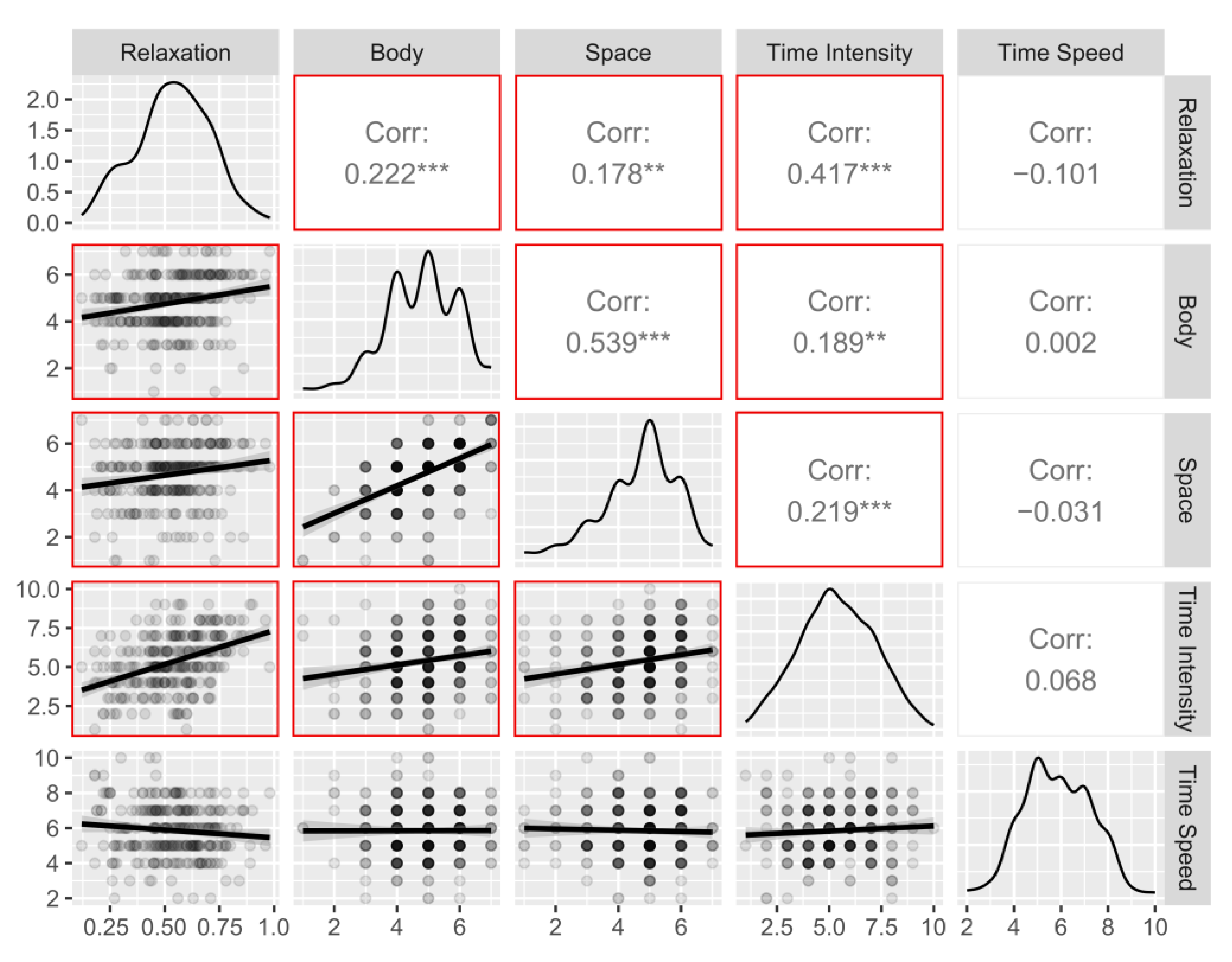
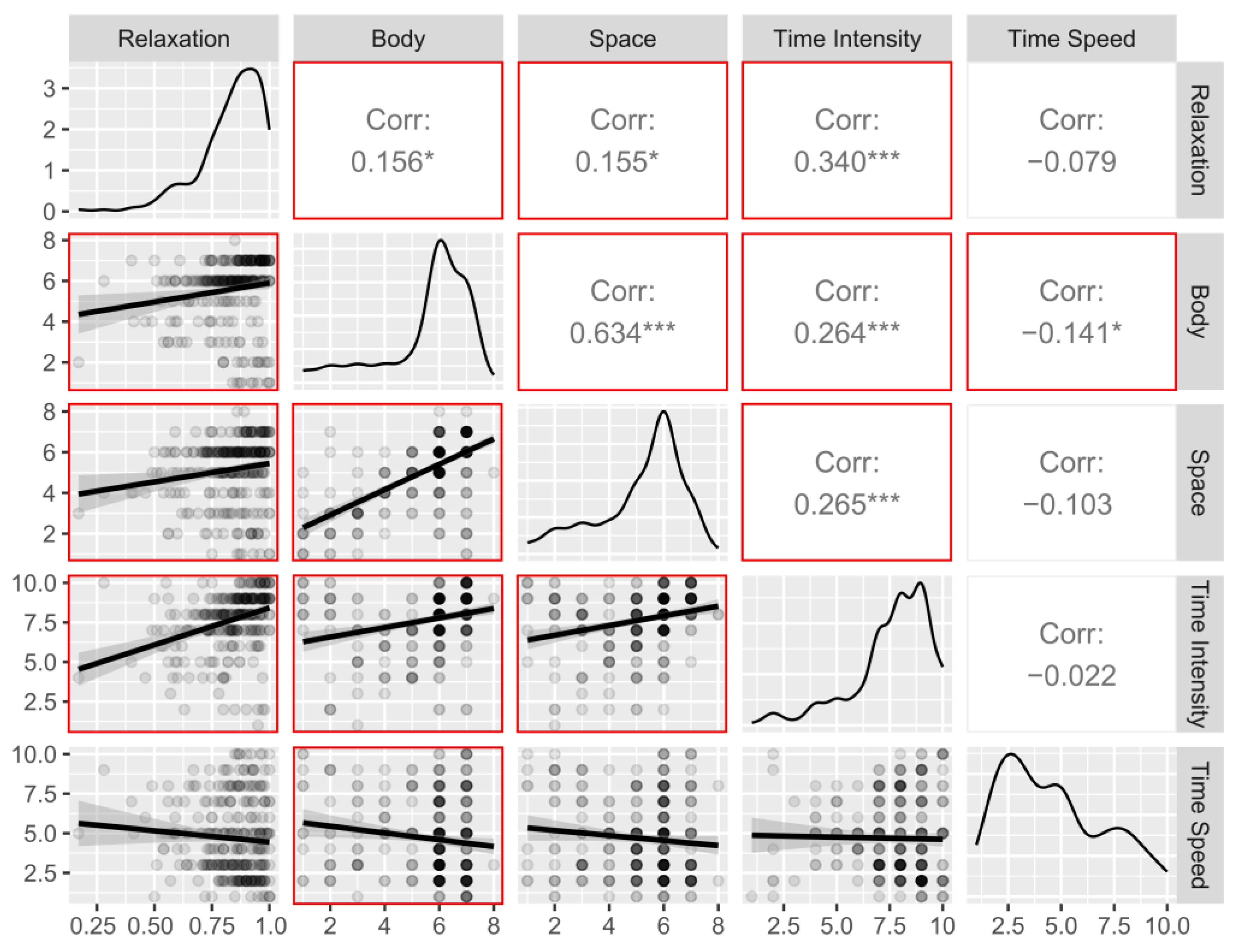
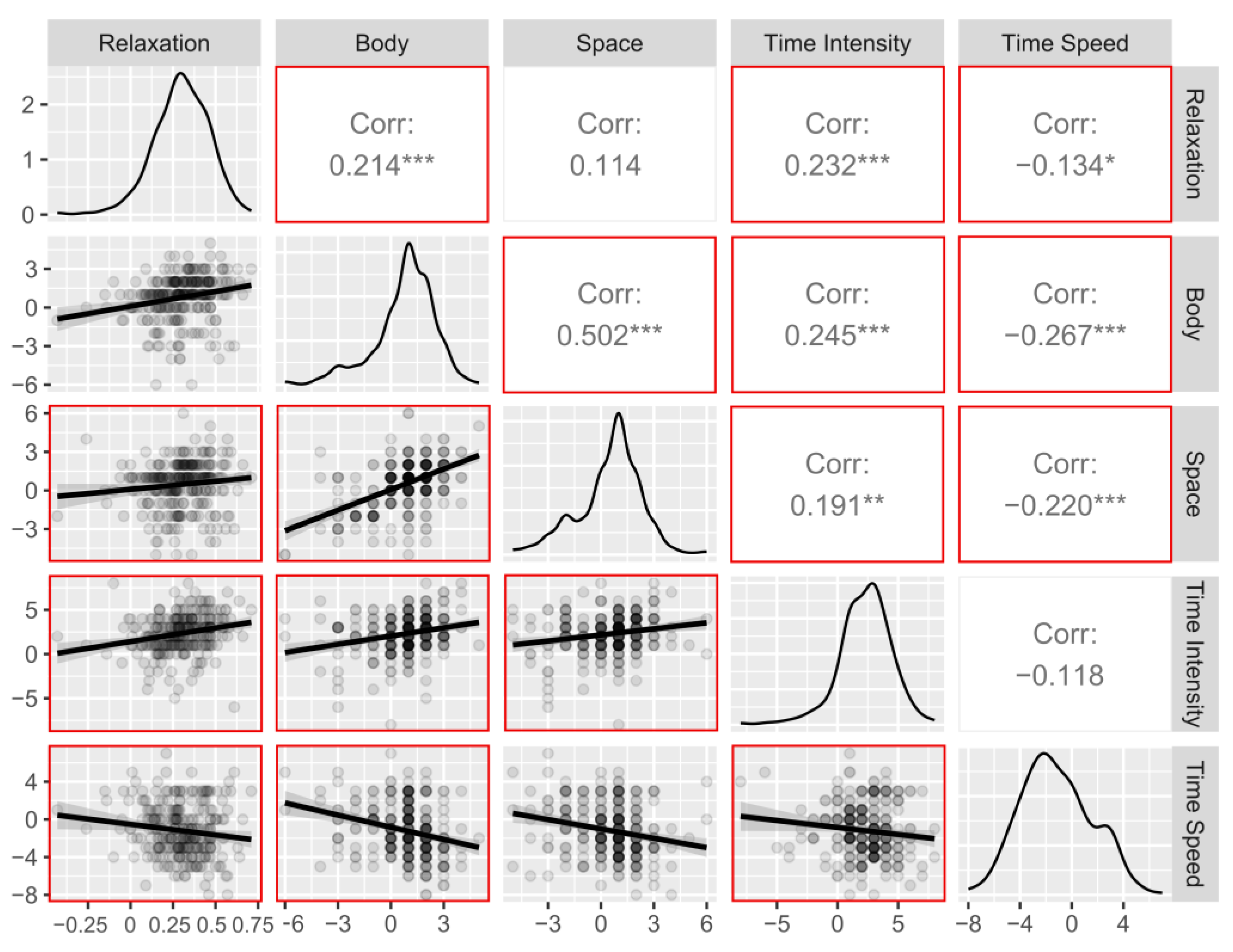
Disclaimer/Publisher’s Note: The statements, opinions and data contained in all publications are solely those of the individual author(s) and contributor(s) and not of MDPI and/or the editor(s). MDPI and/or the editor(s) disclaim responsibility for any injury to people or property resulting from any ideas, methods, instructions or products referred to in the content. |
© 2023 by the authors. Licensee MDPI, Basel, Switzerland. This article is an open access article distributed under the terms and conditions of the Creative Commons Attribution (CC BY) license (https://creativecommons.org/licenses/by/4.0/).
Share and Cite
Pintimalli, A.; Glicksohn, J.; Marson, F.; Di Giuseppe, T.; Ben-Soussan, T.D. Change in Time Perception Following the Place of Pre-Existence Technique. Int. J. Environ. Res. Public Health 2023, 20, 3509. https://doi.org/10.3390/ijerph20043509
Pintimalli A, Glicksohn J, Marson F, Di Giuseppe T, Ben-Soussan TD. Change in Time Perception Following the Place of Pre-Existence Technique. International Journal of Environmental Research and Public Health. 2023; 20(4):3509. https://doi.org/10.3390/ijerph20043509
Chicago/Turabian StylePintimalli, Andrea, Joseph Glicksohn, Fabio Marson, Tania Di Giuseppe, and Tal Dotan Ben-Soussan. 2023. "Change in Time Perception Following the Place of Pre-Existence Technique" International Journal of Environmental Research and Public Health 20, no. 4: 3509. https://doi.org/10.3390/ijerph20043509





